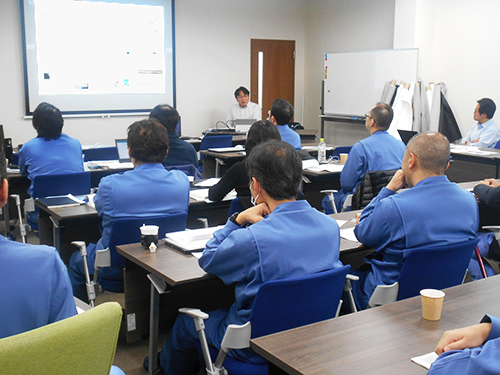Training of Human Resources
Approach toward recruitment and training of human resources
The labor policy of our Group is based on the idea that “the most important resource of a company is its people, and the root of corporate growth and development is to utilize the abilities, skills, and creativity of its human resources,” and we focus on creating a rewarding workplace by assigning the right person for the right job based on the results of multifaceted personnel evaluations, fair evaluation of skills, and environmental improvement.
In order to secure the human resources necessary for the development of the company, we mainly hire mid-career workers, but Daiichi Kasei also hires new graduates to secure future key personnel, and in both cases, we strive to hire people with motivation and vitality.
Education and training system
Daiichi Kasei has established “Education and Training Conducting Regulations” that stipulate the contents and implementation procedures for education and training of personnel so that the company can comply with the quality management system and environmental management system stipulated by ISO.
Education program
At our company, each employee pursues expertise in his/her own specialized field, and with the exception of compliance education, etc., we do not provide uniform training, but we have established practices where each employee voluntarily takes outside training and seminars to further deepen his/her expertise.
At Daiichi Kasei, each department head makes a plan regarding the competencies (skills, techniques, qualifications, etc.) possessed by respective employees in his/her department as well as their skills and techniques to be developed and qualifications to be acquired in the current fiscal year, and clarifies them in the “Competency Evaluation Skills Map,” and implements on-the-job training (OJT) and necessary education and training for each process according to the Skills Map, and has the employees acquire qualifications and take skill courses required by laws and regulations.When necessary, English training is also provided.
Furthermore, in 2024, we significantly enhanced our training programs by introducing root cause analysis training for troubleshooting, training for HR evaluators and recruitment interviewers, and ISO/IATF training, including for management personnel. As a result, while training hours vary depending on job level and role, despite a busy operational schedule, the average annual training time per employee reached approximately 2.9 days, a substantial increase compared to the 1.5 days recorded in the previous year.

In addition to the usual education and training for new employees, Ultrafabrics offers “Ultrafabrics University,” which educates all employees about products and business processes, and “Health & Wellness Week,” which provides employees with opportunities to learn more about their benefits.
